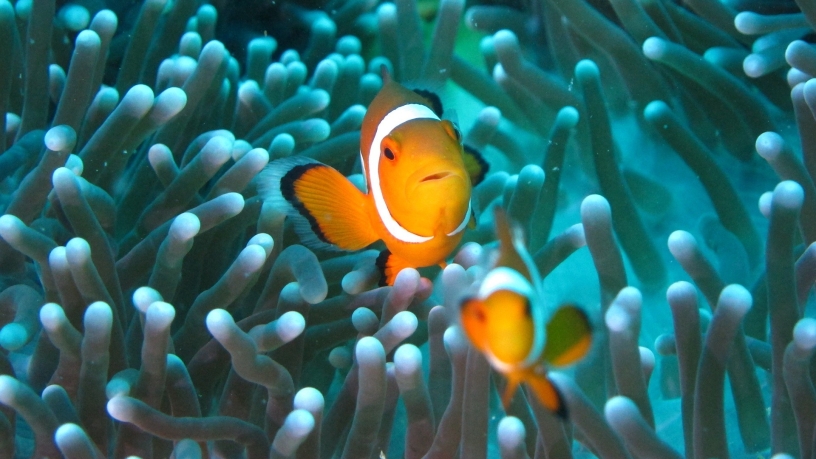We’ve all heard of clownfish, and presumably most of us have seen Finding Nemo, but how much do you actually know about these little guys? I knew very little until I looked them up, and they’ve actually got quite a lot going on.
Clownfish belong to the subfamily Amphiprioninae, and there are thirty different species. Not all of them have the typical orange and white striped look. They can range from yellow to orange to red or black, and can have various degrees of white on them. Clownfish live in the Pacific and Indian oceans, in warm water reefs or lagoons.
One of the most well-known facts about clownfish is their association with sea anemones. Clownfish and anemones form a symbiotic relationship, with each partner benefitting from the other’s presence. The clownfish receives protection from predators in the form of the anemone’s stinging tentacles. The clownfish also gets to eat any scraps of food left behind from the anemone’s meals, and will even eat dead anemone tentacles. Though it seems like it wouldn’t be very nice to have your body parts eaten by your partner, the anemone does get some perks by having the clownfish around. The clownfish defends the anemone from predators, and keeps it clear of parasites. The anemone also gets to snack on tasty clownfish excrement, which not only is a delicious meal, but helps incorporate algae into the anemone, which aids in tissue growth. The clownfish also helps aerate the anemone, by swimming around the anemone tentacles in certain patterns.
A big question about clownfish is why they aren’t stung by the anemone’s tentacles. One possible explanation is the composition of the clownfish’s mucus layer. Instead of being mostly made of proteins, like most fish, the clownfish’s mucus layer is mainly sugar based. This could fool the anemone into thinking the clownfish is not a source of food, thus preventing the anemone from firing its stingers. Another possibility is that clownfish have develop a resistance to their host’s toxins. Experimentally it has been shown that some species of clownfish have developed resistance to the toxin, but not full immunity. Thus it seems like the mucus layer is key to the clownfish’s anemone inhabiting lifestyle.

One thing I definitely didn’t know about clownfish is that they are sequential hermaphrodites. They start their lives as males, and switch to being female when the need arises. In fact, clownfish live in groups with a strict dominance hierarchy. Each group has one female and one dominant male. Only the dominant male mates, and he is the one that takes care of any eggs the female lays. If the female of the group dies, the dominant male switches to being female and every male moves up a rank in the hierarchy.
So in Finding Nemo, when Nemo’s mother dies, Marlin (assuming Marlin was the dominant male) would have turned have turned into a female. I don’t know how much that would have changed the movie, but that’s what would happen. Maybe having a dad turn into a mom would have scarred too many small children. Who knows.

